
Silene is a genus of flowering plants in the family Caryophyllaceae. Containing nearly 900 species, it is the largest genus in the family. Common names include campion and catchfly. Many Silene species are widely distributed, particularly in the northern hemisphere.

Silene laciniata is a perennial herb in the family (Caryophyllaceae), commonly known as fringed Indian pink, cardinal catchfly, Mexican campion, Mexican-pink, and campion.
Hulsea nana is a North American species of flowering plant in the family Asteraceae known by the common name dwarf alpinegold. It is native to the western United States from Washington, Oregon, and far northern California.

Calochortus greenei is a species of flowering plant in the lily family known by the common name Greene's mariposa lily. It is native to northern California and southern Oregon, where it grows in the forest and woodlands of the mountains. It is a perennial herb which produces a branching stem up to about 30 centimeters in maximum height. There is a basal leaf about 20 centimeters long which does not wither at flowering. The inflorescence bears 1 to 5 erect bell-shaped flowers. Each flower has three sepals and three light purple petals with darker areas at the bases. The petals are 3 to 4 centimeters long and have a coat of long hairs on their inner surfaces. The fruit is a winged capsule about 2 centimeters long.

Ericameria greenei is a species of flowering shrub in the family Asteraceae known by the common name Greene's goldenbush. It is native to the mountains of the western United States in Washington, Idaho, Oregon, and the northern California as far south as Lake and Tuolumne Counties.
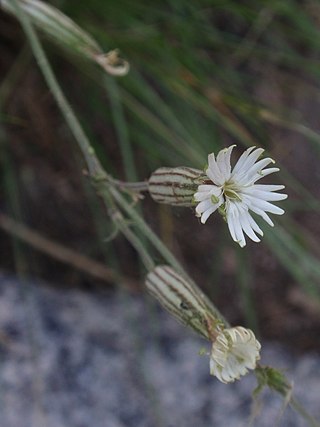
Silene bernardina is a species of flowering plant in the family Caryophyllaceae known by the common name Palmer's catchfly.
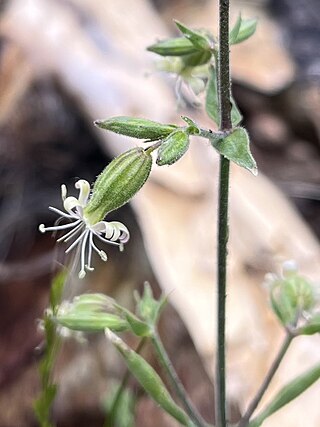
Silene bridgesii is a species of flowering plant in the family Caryophyllaceae known by the common name Bridges' catchfly.

Silene campanulata is a species of flowering plant in the family Caryophyllaceae known by the common names Red Mountain catchfly and bell catchfly. It may be a synonym of Silene greenei.

Silene douglasii is a species of flowering plant in the family Caryophyllaceae known by the common name Douglas's catchfly.

Silene gallica is a species of flowering plant in the family Caryophyllaceae known by several common names, including common catchfly, small-flowered catchfly, and windmill pink. It is native to Eurasia and North Africa, but it can be found throughout much of the temperate world as a common roadside weed.
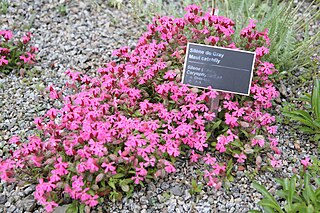
Silene grayi is a North American species of flowering plant in the family Caryophyllaceae, known by the common name Gray's catchfly.
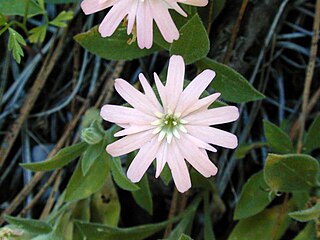
Silene hookeri is a species of flowering plant in the family Caryophyllaceae known by the common names Hooker's silene, Hooker's catchfly, Hooker's Indian pink, and Hooker's glandular campion.
Silene salmonacea is a rare, newly described species of flowering plant in the family Caryophyllaceae known by the common names Klamath Mountain catchfly and salmon-flowered catchfly. It is known only from Trinity County, California, where it grows in the forests of the southern Klamath Mountains. It is a member of the serpentine soils flora. It is a small perennial herb growing just a few centimeters tall. The spoon-shaped leaves are up to 3.5 centimeters long. The herbage is gray-green and lightly woolly in texture. Each flower has a tubular calyx of fused sepals lined with ten veins. There are five salmon pink petals, each with four lobes at the tip.
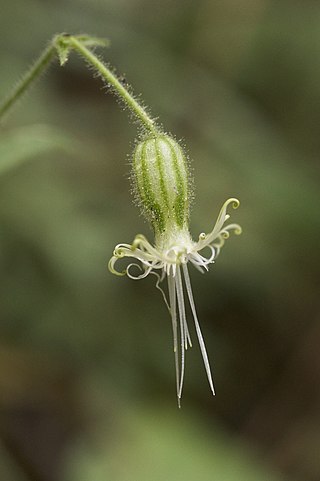
Silene lemmonii is a species of flowering plant in the family Caryophyllaceae known by the common name Lemmon's catchfly.
Silene marmorensis is a rare species of flowering plant in the family Caryophyllaceae known by the common names Marble Mountain catchfly, Marble Mountain campion, and Somes Bar campion. It is endemic to the southern Klamath Mountains of northern California, where it grows in mountain woodlands and forests. It is a perennial herb producing several stems and shoots from a woody, branching caudex and thick taproot. The hairy, glandular stems grow erect to a maximum height near 40 centimeters. The lance-shaped leaves are a few centimeters long and are borne in pairs, the lowermost drying early. The inflorescence is a terminal cyme of flowers at the top of the stem, and some flowers may occur in the leaf axils. Each flower has a hairy, veined calyx of fused sepals. The flowers bloom at night, the five pinkish or green-tinged petals opening at the tip of the calyx.

Silene noctiflora is a species of flowering plant in the family Caryophyllaceae known by the common names night-flowering catchfly, nightflowering silene and clammy cockle. It is native to Eurasia, but it is known on other continents as an introduced species and sometimes a weed. In North America, it is a common weed of grain crops in the Canadian prairie provinces and in much of the United States. It grows in fields and in other disturbed habitat.
Silene nuda is a species of flowering plant in the family Caryophyllaceae known by the common names western fringed catchfly and sticky catchfly.

Silene sargentii is a species of flowering plant in the family Caryophyllaceae known by the common name Sargent's catchfly. It is native to the western United States, where it is known from the mountain ranges straddling the California-Nevada border east of the Sierra Nevada. It is also known from one disjunct occurrence in central Washington. It grows in rocky mountain habitat in subalpine and alpine climates. It is a perennial herb growing from a woody, branching caudex and taproot, sending up several decumbent or erect stems and shoots. It grows no more than about 20 centimeters tall, often taking a clumpy form. The fleshy leaves are widely lance-shaped and a few centimeters in length, most of them occurring around the caudex. Each flower is encapsulated in a hairy, glandular calyx of fused sepals which has stark purple veining. The petals are white to deep pink and each has two or more rounded or pointed lobes at the tip.

Silene scouleri is a species of flowering plant in the family Caryophyllaceae known by the common names simple campion and Scouler's catchfly.
Silene seelyi is a species of flowering plant in the family Caryophyllaceae known by the common names Seely's catchfly and Seely's silene. It is endemic to Washington state in the United States, where it is limited to the Wenatchee Mountains of Chelan and Kittitas Counties.















